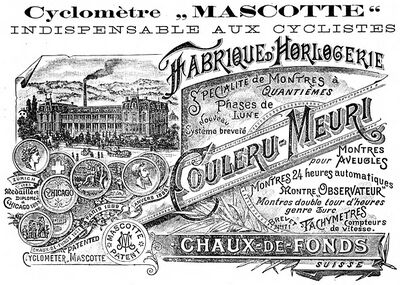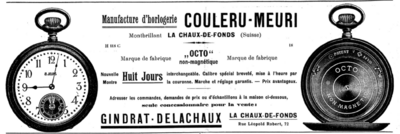Charles Couleru-Meuri
Charles Couleru-Meuri was a watchmaker located in La Chaux-de-Fonds from 1880 through the 1920s and his namesake firm was one of the most important makers of complicated watches in the city.
Born Charles-Frédéric Couleru in 1851, he married Maria-Julia Möri and took the alliance name of Couleru-Meuri. He was active from at least 1880 through bankruptcy in 1899, then continued to be involved in his namesake company under Parisians Hector Lévy and Georges Meyer who used the intellectual property to build the Utinam factory in Besançon. Couleru-Meuri himself continued with a new firm and invented 8-day watches in association with L. Sandoz-Vuille of Le Locle. His son Eugène Couleru founded Montres Octo to produce similar watches but faced bankruptcy himself in the economic downturn of the 1920s. Couleru-Meuri's legacy is seen in the Besançon watch industry (including a modern Utinam), 8-day watches and clocks from Octo, Rode, and Octava, and the Montbrillant Watch Manufactory building he shared with Breitling in the 1890s.
History
Charles-Frédéric Couleru was born in Fontainemelon on December 27, 1851. He was the son of Charles Couleru (1821-1892). Me married Maria-Julia Möri (November 27, 1856-May 22, 1945) of Neuchatel before 1880. Her name is consistently spelled Möri (in both official marriage and death announcements) though the family used Meuri (sometimes misspelled Meury).
Charles and Maria-Julia received a divorce and separation of property on July 28, 1898 but the couple appear to have remained close. In fact their son Charles was born two years later. Maria-Julia's mother was Virginie Ruedin, connecting her to a famous family of watchmakers including Jämes-Louis-François Ruedin, head of the Corgémont branch of FHF (possibly her brother or cousin). When she died, Charles Couleru-Meuri took out advertisements inviting her friends to come to her funeral, demonstrating his affection for her. On Charles' death Maria-Julia was consistently called his wife and widow.
Charles Couleru-Meuri located his workshop at 9 Rue Neuve as early as 1880. Some sources date the start of the company to as early as 1848, but this would have to have been his father, also named Charles Couleru. Charles Couleru-Meuri produced high-end and complicated pocket watches, specializing in moon phase indicators and ultra-thin models.
In 1875 the firm of Hahn et Couleru is listed in Boudry as a maker of ebauches (remontoirs). This follows the 1873 registration of a perfected crown winding mechanism in France by a Mr. Couleru. In 1880 C. Couleru-Meuri is listed in La Chaux-de-Fonds as a maker of watches at Rue Neuve 9. The first survey of business owners in 1883 lists Charles Couleru-Meuri of Fontainemelon as the manager of the watchmaking operation known as Couleru-Meuri.
The company registered the Minerva brand name and logo in May 1886 (registration number 1587). This is followed by a star in a belt with the company name, registered June 1887 (number 1944) for watch movements. The next brand name was Mascotte, inside a double diamond logo, registered November 28, 1887 (number 2099) and an intriguing registration for a hand inside a sub-dial with moon and stars, registered December 1 (number 2112). Next was the registration of Bicycle Club Watch - Observator on August 14, 1888 (number 2384). He registered a brand for use in Arabia with 171 (in Eastern Arabic numerals) above a star and crescent on December 12, 1891 and this was revised with the slogan "Once Upon a Time, a Certificate of Excellence" in Arabic added on April 17, 1899. Next was the Mascotte brand, registered inside a circle with the text "Compteur Kilometrique" around a "CM" script on May 8, 1893 (number 6409) and a more casual "La Mascotte" script mark on January 18, 1897.
Couleru-Meuri received a third-class medal at the International Watch Exhibition at La Chaux-de-Fonds in 1881, the first of many accolades. Charles Couleru-Meuri was recognized in Geneva in 1881 for advantageous production methods and good use of power. The company was recognized for its calendar watch movements at Zürich in 1883 and received medals at Antwerp in 1885 and Paris in 1889 and 1893. The company was also recognized at the World's Columbian Exhibition in Chicago in 1893.

In 1894 Couleru-Meuri relocated to a large factory at 18 Boulevard du Petit-Château, next to Léon Breitling's workshop. By 1901, this was listed as 1 Rue(lle) Montbrillant as the road had been disconnected. This large factory was called Montbrillant Watch Manufactory by Breitling and remained closely associated with the production of complicated pocket watches and 8-day clocks for decades even after Couleru-Meuri moved on. The company also diversified, introducing a line of cycling odometers under the Mascotte brand by 1884.
Couleru-Meuri was well known for complicated watches, including those with a 24 hour display, with calendar and moon phase indicator, and special watches for the blind and stopwatches. By 1892, Couleru-Meuri had patented a moon phase indicator with a concentric subdial pointer, and aggressively defended this design. The company also collected numerous other patents, including early chronograph indications, ultra-thin designs, and an 8-day movement.
In 1893, the firm patented an unusual 24 hour watch featuring a disc with alternating numbers 1-12 and apertures that would shift at noon to show the numbers 13-24. This was developed at the time but not produced in volume. A controversy arose in 1913 when a French firm, Adrien Castenceau, patented the same design without credit. Couleru-Meuri's patents 7197 and 7198
Bankruptcy proceedings were initiated on Charles Couleru-Meuri on May 3, 1898 with an assembly of creditors on June 1. This action was revoked a year later as Couleru-Meuri received additional investment to continue operation as Hector Lévy, successor to C. Couleru-Meuri, in November 1900. This Paris businessman had been an associate of Couleru-Meuri previously and acquired all of Couleru-Meuri's trademarks the following year. Lévy, for his part, passed ownership of the firm to Georges Meyer, another Parisian, on November 1, 1902. Meyer and Lévy opened a new factory in Besançon called Utinam in 1906 and renamed the former Couleru-Meuri operation Fabrique Utinam in 1909. Meyer ran the company until it was closed in 1927.
Charles Couleru-Meuri collaborated with Gindrat-Delachaux on the development of an 8-day watch after the turn of the century. The two had shared the Montbrillant Watch Manufactory a few years before and would have been familiar with the novel Hebdomas watch invented by Irénee Aubry and produced by him and Arthur Graizely. Two 1903 patents feature both the Couleru-Meuri and Gindrat-Delachaux names: CH28244 (for a winding mechanism) and CH29070 (for a large power reserve barrel). By this point, Couleru-Meuri had registered a complete design for his own 8-day watch, receiving patent CH28536 in May.

By 1904 Couleru-Meuri was producing an 8-day watch using Charles Couleru-Meuri's patented movement. This was the first product to use the Octo brand and was distributed by Gindrat-Delachaux who would later be a competitor in this market. These watches featured an open heart dial showing the balance at 6 like Irénee Aubry's Hebdomas but used a full-diameter dial unlike that famous watch.
The company then offered technical services to other watchmakers in La Chaux-de-Fonds, resisting the drive to mass production just as Charles Couleru-Meuri had done. The company also began working closely with the commercial distributor Gindrat-Delachaux, also of La Chaux-de-Fonds, at this time and many watches and patents are issued in the name of both. It retains the name, Charles Couleru-Meuri, through this time period, so it is likely that the eponymous watchmaker remained involved.
A new business called Charles Couleru-Meuri, Fabrique du Petit Château, was created in February, 1905. It was located at Rue de Montbrillant 1 by Charles-Frédéric Couleru-Meuri and his son Eugène-Léon Couleru. This company too initiated bankruptcy proceedings on May 4, 1908. It was deleted from the commercial registry on June 3 of that year.
The following year, Eugène is the proprietor of the Couleru-Meuri watchmaking business, now located at Rue Jaquet-Droz 47. Charles Couleru-Meuri appears to have lived a while longer, however, and his home address is listed at Rue de la Promenade 16 through 1917. In 1918, the home is listed as belonging to Vve. Couleru-Meuri, suggesting that Charles died in 1917. She is no longer listed after this year either.
Charles Couleru-Meuri died on November 7, 1917 in La Chaux-de-Fonds. He was survived by his widow as well as his children, Eugène, Henri, Jeanne-Marguerite (1889-1981), and Charles. His daughter Alice had died at 13 years of age in 1907.
The final reminder of Couleru-Meuri and Montres Octo is the sign which is still visible on the Montbrillant Watch Manufactory: It specifies "8 Jours", a reference to the tenant from 1894!
Patents
- FR97725, January 7, 1873 - Perfectionnament dans le construction des remontoirs de montres
- CH171, January 28, 1889 - Montre double-tour d'heures et minutes, remontoir au pendant avec deux mises à l'heure (deleted March 1894)
- CH171/45, January 10, 1890 - Montres double tour d'heures et minutes, remontoir au pendant avec deux mises à l'heure (deleted March 1894)
- CH2535, October 9, 1890 - Nouveau mécanisme de remontoir à bascule pour montres (deleted January 1893)
- CH5609, August 5, 1892 - Compteur pour distances parcourues (deleted November 1896)
- CH5609/135, March 2, 1893 - Compteur pour distances parcourues (deleted November 1896)
- CH6472, February 25, 1893 - Tachymètre ou contrôleur de vitesse pour les véhicules (deleted May 1894)
- CH7197, October 27, 1893 - Nouvelle montre 24 heures (deleted February 1896)
- CH7198, November 9, 1893 - Nouvelle montre 24 heures (deleted February 1896)
- CH8925, September 6, 1894 - Obturateur photographique perfectionné (deleted December 1895)
- CH13899, March 7, 1897 - Nouveau mouvement d'horlogerie pour montres-remontoir extra-plates (deleted June 1899)
- CH14195, March 26, 1897 - Mécanisme pour transmission variable de vitesse (deleted July 1899)
- CH22190, December 18, 1900 - Montre (patented by Hector Lévy, deleted March 1903)
- CH28244, May 25, 1903 - Mécanisme de remontoir et de mise à l'heure (with Gindrat-Delachaux, deleted August 1904)
- CH28536, May 18, 1903 - Montre à marche de longue durée (key patent for Octo watches)
- CH28537, May 18, 1903 - Coq pour montres (deleted August 1908)
- CH29070, September 23, 1903 - Barillet de montre. (registered jointly with Gindrat-Delachaux but transmitted to Couleru-Meuri solely in 1906)
- CH31930, August 30, 1904 - Appareil indicateur de vitesse pour véhicules de tous genres. (sold to Flory, Reingpach & Co. of Colchester, England, in 1906)
- FR348053, September 16, 1904 - Appareil indicateur de vitesse pour tous véhicules.
- GB190421012, June 15, 1905 - Speed Indicator
Family
- Charles Couleru (1821-September 7, 1892)
- Charles-Frédéric Couleru (December 27, 1851-November 7, 1917) married before 1880 Maria-Julia Möri (November 27, 1856-May 22, 1945)
- Eugène Couleru (-August 1936)
- Henri Couleru
- Jeanne-Marguerite Couleru (Early July 1889-December 21, 1981) married ? Stockburger
- Alice-Marie Couleru (March 8, 1893-July 9, 1907)
- Charles Couleru (July 30, 1900-after 1981)
- Charles-Frédéric Couleru (December 27, 1851-November 7, 1917) married before 1880 Maria-Julia Möri (November 27, 1856-May 22, 1945)
- Maria-Julia Meuri was daughter of ? Meuri and Virginie Ruedin (1828?-October 1882)